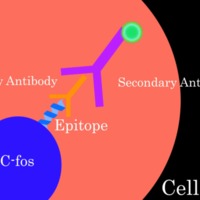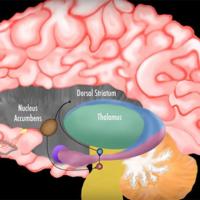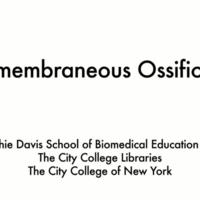Browse Exhibits (13 total)
Cfos - Immunolabeling

Cfos Immunolabeling
Brief animation showing how a primary and secondary antibody are used to detect C-fos, an immediate early gene transcribed as a result of recent neural activity. To see why and how C-fos is made please watch the companion video Cfos neural activity
Cfos Neural Activity

Cfos Neural Activity
This animation shows how electrical impulses generated by neurons (action potentials) lead to the expression of C-fos by the cell nucleus. C-fos is thus considered an immediate early gene product of recent neural activity. It is widely used in neuroscience as a post-hoc readout of recently active neurons. To see how C-fos is detected experimentally for visualization and quantification please watch the companion video C-fos Immunolabeling.
Cocaine Addiction Effects of the Brain: Binge and Craving

Cocaine Addiction Effects of the Brain: Binge and Craving
Cocaine afflicts many individuals and is potently addictive. Originally hailed as a wonder-drug in the late 19th century, cocaine is now considered an illegal substance. Cocaine’s addictive properties can be attributed to changes in the dopamine reward pathway of the Ventral Tegmental Area and Substantia Nigra, Prefrontal Cortex, Dorsal Striatum, Nucleus Accumbens, Amygdala, Globus Pallidus, and Hippocampus. This drug affects the brain in two processes: binge and crave. The binge process highlights cocaine’s ability to block dopamine reuptake from the synapse resulting in hyperstimulation of the postsynaptic neuron in the dopamine reward pathway. The crave process promotes drug-seeking behavior through conditional and contextual cues. Understanding the effects of cocaine in the brain may grant insight in creating future medication and therapies to treat individuals addicted to this drug.
Crispr-Cas 9

Crispr-Cas 9
Precise modification of faulty genes for repair has been one of the most important goals in medicine. It is now finally within the realm of possibility thanks to the gene editing tool CRISPR. This microbial adaptive immune system can copy and cut specific DNA sequences. This animation provides a visual introduction of this revolutionary genetic tool.
Endochondral Ossification

Endochondral Ossification
This animation describes Endochondral Ossification which is a process of long, short and irregular bone formation using byline template.
Endocrine Gland

Endocrine Gland
This animation describes the formation of endocrine glands starting with the mitosis of mesenchymal tissues, eventually leading to the formation of the secretory portion of the gland by differentiation.
Exocrine Gland

Exocrine Gland
This animation describes the formation of exocrine glands starting with the mitosis of mesenchymal tissues, eventually leading to the formation of the secretory portion of the gland by differentiation.
Formation of Cartilage

Formation of Cartilage
This animation describes the process of cartilage formation starting with separation from the mesenchymal tissue to the formation of an isogenous cell group via mitosis.
Intramembraneous Ossification

Intramembraneous Ossification
This animation describes Intramembranous ossification which is a process of bone formation.
Myeloid Cell Development

Myeloid Cell Development
This animation describes the process of WBC formation from myeloblast.

